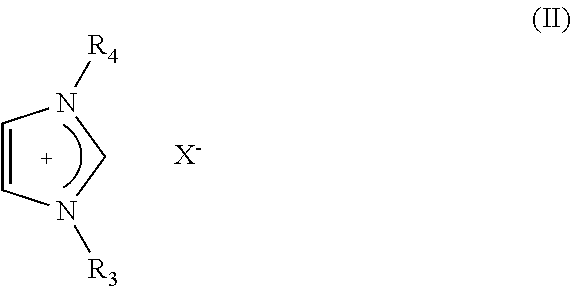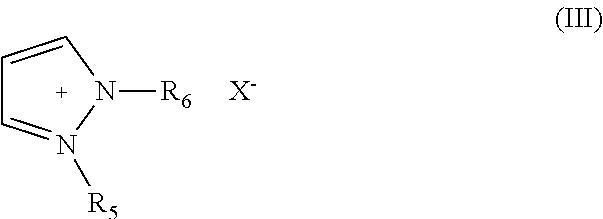Electric Al-Zr-Mn Alloy-Plating Bath Using Room Temperature Molten Salt Bath, Plating Method Using the Same and Al-Zr-Mn Alloy-Plated Film
a technology of molten salt bath and alloy, applied in the direction of cell components, coatings, transportation and packaging, etc., can solve the problems of aluminum having a strong affinity for oxygen, the reduction potential of hydrogen is inferior, and the electro-deposition of aluminum layers from aqueous solutions containing the same is quite difficult, and achieves high corrosion resistance
- Summary
- Abstract
- Description
- Claims
- Application Information
AI Technical Summary
Benefits of technology
Problems solved by technology
Method used
Image
Examples
examples
[0055]The present invention will be described in detail below with reference to the following non-limiting Examples and Comparative examples.
examples 1 to 4
[0056]Toluene, as an aromatic hydrocarbon solvent was blended, in an amount of 35% by volume, with a bath prepared by melt blending AlCl3 and 1-methyl-3-propylimidazolium bromide at a molar ratio of 2:1 and then manganese chloride and zirconium chloride were added to the resulting blend in each corresponding amount as specified in the following Table 1 to thus give an electric Al—Zr—Mn alloy-plating bath. Then an iron plate (thickness: 0.5 mm) used as a cathode was subjected to pretreatments. More specifically, the iron plate was degreased with an alkali, washed through the alkali-electrolysis, then washed with an acid, washed with water and then with ethyl alcohol and finally dried. Using the foregoing iron plate as a cathode and an aluminum plate (purity: 99.9%) as an anode, these electrodes were immersed in the foregoing electric Al—Zr—Mn alloy-plating bath maintained at 60° C. in a dry nitrogen gas atmosphere for 5 minutes and then the Al—Zr—Mn alloy-plating was carried out usin...
examples 5 to 8
[0057]There were added 0.02 mole / L of manganese chloride and 0.015 mole / L of zirconium chloride to a bath prepared by melt blending AlCl3 and 1-methyl-3-propylimidazolium bromide at a molar ratio of 2:1. Further, a variety of additives as specified in the following Table 2 were added to the resulting bath in amounts likewise specified in Table 2 to thus give each corresponding electric Al—Zr—Mn alloy plating bath. Then an iron plate (thickness: 0.5 mm) used as a cathode was subjected to pretreatments. More specifically, the iron plate was degreased with an alkali, washed through the alkali-electrolysis, then washed with an acid, washed with water and then with ethyl alcohol and finally dried. Using the foregoing iron plate as a cathode and an aluminum plate (purity: 99.9%) as an anode, these electrodes were immersed in the foregoing electric Al—Zr—Mn alloy-plating bath maintained at 50° C. in a dry nitrogen gas atmosphere for 5 minutes and then the Al—Zr—Mn alloy-plating was carried...
PUM
| Property | Measurement | Unit |
|---|---|---|
| concentration | aaaaa | aaaaa |
| concentration | aaaaa | aaaaa |
| time | aaaaa | aaaaa |
Abstract
Description
Claims
Application Information
 Login to View More
Login to View More - R&D
- Intellectual Property
- Life Sciences
- Materials
- Tech Scout
- Unparalleled Data Quality
- Higher Quality Content
- 60% Fewer Hallucinations
Browse by: Latest US Patents, China's latest patents, Technical Efficacy Thesaurus, Application Domain, Technology Topic, Popular Technical Reports.
© 2025 PatSnap. All rights reserved.Legal|Privacy policy|Modern Slavery Act Transparency Statement|Sitemap|About US| Contact US: help@patsnap.com



